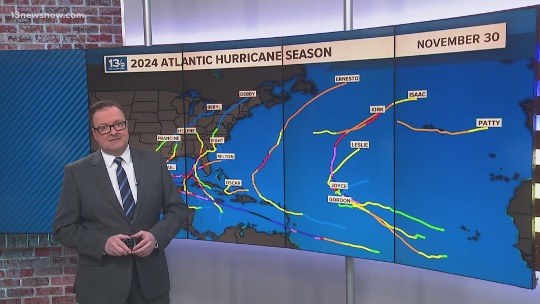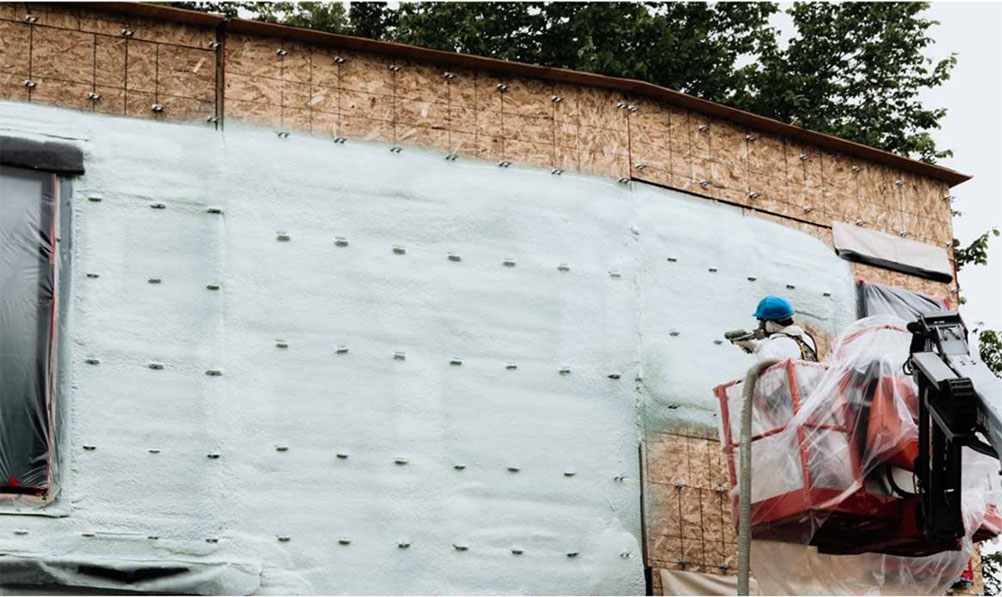From unprecedented lulls to rapidly-developing systems, the 2024 Atlantic Hurricane Season lived up to expectations as another active season.

Author: Evan Stewart
Published: 6:55 PM EST December 5, 2024
NORFOLK, Va. — The 2024 Atlantic hurricane season, which officially ended on November 30, was another active season, with several records set. A mix of unusual weather patterns and significant storms highlighted how difficult it can be to predict tropical systems.
In a typical hurricane season, the Atlantic averages 14 named storms, 7 hurricanes, and 3 major hurricanes, storms of Category 3 strength or higher. The 2024 season exceeded those benchmarks, with 18 named storms, 11 hurricanes, and 5 major hurricanes.
The 2024 had its slowest start since 2014, with Tropical Storm Alberto forming in the Gulf of Mexico on June 19th.
Next came Hurricane Beryl, the earliest-forming Category 4 and Category 5 Atlantic hurricane on record, and the strongest June and July hurricane on record in the basin. Beryl formed on June 28 and rapidly intensified as it approached the Windward Islands, peaking as a Category 5 hurricane early on July 2. Short-lived Tropical Storm Chris formed on June 30 and moved ashore the next morning.
After Beryl dissipated on July 11, the Atlantic basin encountered a lull in activity due to the Saharan air layer, which suppresses tropical activity.
August saw Hurricanes Debby and Ernesto before another lull in activity occurred.
After nearly three weeks of inactivity, the longest in over fifty years at that point in the season, activity quickly ramped up, with a “backloaded” tropical season. September saw six storms form: Francine, Gordon, Helene, Isaac, Joyce, and Kirk. The remnants of Helene caused massive flooding in the mountains of North Carolina and Virginia.
Early October saw the formations of Hurricanes Leslie and Milton. Milton underwent rapid intensification in the Gulf of Mexico, becoming the second Category 5 hurricane of the season. Milton became the first Atlantic hurricane since Hurricane Wilma (2005) to reach a pressure below 900 mb, and the second-most intense tropical cyclone ever recorded over the Gulf of Mexico, only after Hurricane Rita (2005).
Later in October, Tropical Storm Nadine and Hurricane Oscar formed.
Early November saw the formation of Tropical Storm Patty, followed by Hurricane Rafael. Then, in mid-November, Tropical Storm Sara formed over the western Caribbean.
The 2024 Atlantic hurricane season was a particularly devastating season with over $220 billion in damages and 400 deaths, most of which came from Hurricanes Beryl, Helene, and Milton.
Flooding was the leading factor of property losses and deaths. All indications are increasing threats to life and property due to more frequent and intense storms, increased population density particularly in areas subject to storms and increasing rainfalls subjecting more area to historic flood levels. High winds, embedded tornadoes, abnormal amounts of precipitation, major flooding and coastal surges, along with extensive areas, thousands of square miles, of the various storm’s coverage, make hurricanes a major threat to millions of households and business. Even with two periods of limited or no hurricane activity this past season, we witnessed strong evidence of heightened damages and loss of life from powerful storms and their influence being extended well inland. All indications are the hazards will continue to increase and not abate. Now is the time to prepare these escalating risks.
Extreme Weather Hazards and Protection – Hurricanes
Green Shield Products provides innovative roofing system’s with unique warranties designed to offer exceptional protection and value. These exclusive warranties include:
- Unlimited wind coverage for up to Category 5 hurricanes.
- Severe hail resistance, ensuring durability in extreme weather conditions.
- Leak-proof warranties extending up to 30 years, offering long-term peace of mind.
Additionally, Green Shield’s products qualify for tax deductions by significantly reducing energy consumption. Backed by ASHRAE 90.1 energy models, our products can provide detailed insights into the percentage of energy savings you can expect compared to past energy bills. This added benefit not only contributes to long-term cost savings but also promotes sustainability and efficiency in your building. The roofing systems achieve a GWP rating of 1, emphasizing their environmental sustainability. Green Shield also offers comprehensive on-site support, ensuring customized roofing and insulation solutions tailored to your specific needs.
Spray Foam’s Hurricane, Flood & Wind Resistance Performance in Commercial Facilities By Maxime Duzyk May 11, 2021. See FEMA updates as of June 2024
The increasing number and intensity of hurricanes and storms in the United States is not only cause for general safety concern but is top-of-mind for builders, contractors and facility owners who have witnessed the damage that may be incurred to commercial structures. Stanford University researchers recently attributed a $75 billion price tag specifically to the flood damage incurred in the U.S. over the past three decades, caused by intensifying rainfall driven by climate change. Another report by reinsurance company Munich Re determined that in 2020 the world’s six most expensive disasters occurred in the U.S., the worst of which was Hurricane Laura.
Commercial facilities are in fact vulnerable to serious storms and inclement weather. First Street Foundation, the non-profit research and technology group, asserts that more than 14 million properties across the Unites States are susceptible to flood damage. Luckily building material innovations have resulted in options that, when applied properly, can assist in protecting commercial facilities from severe weather events as they grow in frequency and intensity. Closed cell spray polyurethane foam (SPF) is one such material. When applied in a seamless, contiguous manner in walls, ceilings, floors and on the roof, closed cell SPF protects the structure from serious, costly damage.
Structural Strength and Wind Resistance
The application of closed cell spray polyurethane foam in above grade walls can also increase the structural strength of buildings and assist with wind resistance. The degree of hardening depends primarily on the strength of the building to begin with. For example, an I-beam modular constructed metal building with a 22-gauge metal panel will benefit significantly less from an interior application of closed cell spray polyurethane foam than a post-frame constructed building with 29-gauge corrugated metal panels will. When installed, closed cell SPF essentially glues the assembly together, reduces the potential for movement and adds a tensile strength average ranging from 40 psi to 70 psi and compressive strength of 40-80 psi.
The Spray Polyurethane Foam Alliance conducted racking performance tests in 1992 and 1996 and at Architectural Testing, Inc. in York, PA in 2007 demonstrating that medium density closed cell SPF, installed at 2.0 pounds per cubic foot, increases racking strength by 70% to 200% in wall assemblies sheathed with oriented strand board (OSB), plywood, gypsum wallboard, vinyl siding and polyiso board. The research proved closed cell SPF significantly increased rack and shear strength in both wood and metal construction. Installed SPF also increases the strength of weaker substrates such as gypsum drywall, vinyl siding and polyiso foam insulation at a much greater percentage than stronger substrates such as OSB and plywood. Notably, special bracing for wind resistance is not required for strengthening purposes when using closed cell spray foam in walls. Since that time closed cell spray foam formulations have been upgraded to HFO blends which have even greater compressive strength (40-80 psi) and very low CWP of 1; which is the same as CO2.
In addition, the racking strength increase is not just a spot measure but applies to the whole structure. It is applied in a seamless fashion with no breaks, gaps in coverage or flex points. Thus, the structure is resistance to the shearing and multidirectional forces exerted during extreme weather conditions of hurricanes, tornados and earthquakes.
Roofing & Wind Uplift
Spray polyurethane foam roofing, a denser closed cell option from 2.5 to 3.5 pounds/ft3, is also an ideal solution for commercial structures located in hurricane prone regions such as the Southeast, Gulf Coast, East and West Coast and Puerto Rico. The material’s adhesion qualities make it particularly ideal where severe weather cycling, storms, wind, hail and other conditions frequently cause damage. As a roofing material, spray foam forms a durable, monolithic membrane over the roof and offers a compressive strength of approximately 40 to 80 pounds per square inch, depending on its density. See chart in increasing hazard section. It also changes little with time and, when properly maintained has an indefinite life span.
Spray foam roofing increases wind uplift resistance when installed to the roof substrate and, when applied to concrete, wind uplift protection is even stronger. The material also resists peeling failure, which is a result of wind pulling flashings and copings away from a roof’s edges, which can ultimately lead to devastating damage to the structure.
Current high-performance spray foams demonstrate wind uplift resistance by meeting the High Velocity Hurricane Zone (HVHZ) criteria of the Florida Building Code. Notably, the material’s ability to withstand leaks due to hail is also unsurpassed.
The National Institute of Standards and Technology reviewed roof damage following Hurricane Katrina and discovered that buildings roofed with spray foam performed well without blow-off of the SPF or damage to flashings. The 2006 report found only one of the examined SPF roofs incurred notable damage and concluded that spray foam kept the roofs intact, prevented moisture from entering the buildings, and protected the structures from hail and debris.
Water Resistive Barrier & Flood Resistance
Closed cell spray foam is ideal for continuous insulation applications in commercial structures and can be used in both interior and exterior applications where it can essentially replace commonly utilized rigid XPS and PIR foam boards. The material boasts extremely low water absorption as well as resistance to mold, as demonstrated with ASTM C1338. Closed cell spray foam excels as a water resistive barrier on exterior applications and is tested in accordance with ASTM E2357 with a pressure up to 300 Pa for Air Barrier Assemblies which included the ASTM E331 (AC71) Water Penetration Testing. The result was no leakage through the spray foam.
When applied in walls, ceilings and floors, FEMA names it a Class 5 material, the highest classification for products indicating strong resistant to floodwater damage. Class 5 materials do not require special waterproofing protection, can survive wetting and drying and may be successfully cleaned after a flood to render them free of most harmful pollutants. In order for FEMA to consider a material to be flood-resistant, it must be able to withstand direct contact with floodwater for an extended period (72 hours) of time.
As a Class 5 solution, closed cell spray foam provides both time and money savings for owners of commercial structures which have endured flood conditions and may be applied as cavity insulation or as continuous insulation in commercial structures and still qualify as a Class 5 material. It is the only cavity insulation approved by FEMA with this highest floodwater resistance. When applied under slab as insulation, closed cell spray foam is also flood resistant.
References
- CNBC, Climate Change has Cost the U.S. Billions of Dollars in Flood Damage, Study Finds, https://www.cnbc.com/2021/01/11/climate-change-has-cost-the-us-billions-of-dollars-in-flood-damage.html
- First Street Foundation, The First National Flood Risk Assessment: Defining America’s Growing Risk, http://assets.firststreet.org/uploads/2020/06/first_street_foundation__first_national_flood_risk_assessment.pdf
- FEMA, Flood Damage-Resistant Materials Requirements for Buildings Located in Special Flood Hazard Areas in Accordance with the National Flood Insurance Program, Technical Bulletin 2, August 2008
- Honeywell, Insulation and Waterproofing for Metal Buildings and Metal Roof Systems: The Case for Using Better Insulation and Waterproofing Technologies in Metal Roof Systems and Metal Buildings
- Architectural Testing, Performance Test Report Rendered to Spray Polyurethane Foam Alliance, Project: Racking Load Tests, 2007.
- National Institute of Standards and Technology, Performance of Physical Structures in Hurricane Katrina and Hurricane Rita: A Reconnaissance Report, 2006


